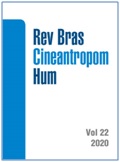Efeito da sobrecarga excêntrica através da tecnologia isoinercial em jogadores profissionais de basquetebol
DOI:
https://doi.org/10.1590/1980-0037.2020v22e59831Resumo
O presente estudo investigou o efeito da sobrecarga excêntrica em jogadores profissionais de basquetebol. Os participantes foram 8 jogadores de uma equipe da Leb Gold League entre 18 e 25 anos. Um ciclo de treinamento de 8 semanas foi realizado com 1 sessão semanal no exercício de meio agachamento. O grupo controle realizou o treinamento com metodologia tradicional, com pesos livres, e o grupo experimental, por meio de tecnologia inercial, com a máquina ProSquat, Proinertial®. O salto vertical e o sprint de 30 metros foram avaliados antes e após a intervenção. As seguintes conclusões foram obtidas: a) o treinamento de força com um componente no vetor vertical mostra melhorias no teste de 30 metros e no salto vertical; b) um programa que afeta a sobrecarga de movimento excêntrico apresenta resultados com melhores desempenhos do que o treinamento tradicional; c) o treinamento no vetor vertical também afeta uma expressão da força no vetor horizontal, mostrando melhorias no sprint de 30 metros.Referências
Gonzalo-Skok O, Tous-Fajardo J, Arjol-Serrano J. L, Suarez-Arrones L, Casajús J. A, Mendez-Villanueva A. Improvement of Repeated-Sprint Ability and Horizontal-Jumping Performance in Elite Young Basketball Players with Low- Volume Repeated-Maximal-Power Training. Int J Sport Physiol Perform 2016; 11(4):464–473.
Tous- Fajardo, J. Nuevas tendencias en fuerza y musculación. (J. Tous, Ed.). Barcelona; 1999
Alemdaroğlu U. The Relationship Between Muscle Strength, Anaerobic Performance, Agility, Sprint Ability and Vertical Jump Performance in Professional Basketball Players. J Hum Kinet 2012; 31(1):99–106.
Balsalobre-Fernández C, Nevado-Garrosa F, del Campo-Vecino J, Ganancias- Gómez, P. Repetición de esprints y salto vertical en jugadores jóvenes de baloncesto y fútbol de élite. Apunt Educ Fis Deport 2015; 120(2):52–57.
Maroto-Izquierdo S, García-López D, de Paz JA. Functional and Muscle- Size Effects of Flywheel Resistance Training with Eccentric-Overload in Professional Handball Players. J Hum Kinet 2017; 60(1):133–143.
Struzik A, Pietraszewski B, Zawadzki J. Biomechanical Analysis of the Jump Shot in Basketball. J Hum Kinet 2014; 42(1):73–79.
Tous-Fajardo J, Gonzalo-Skok O, Arjol-Serrano JL, Tesch P. Enhancing change-of-direction speed in soccer players by functional inertial eccentric overload and vibration training. Int J Sport Physiol Perfor 2016;11(1): 66-73.
Berg HE, Tesch AA. gravity-independent ergometer to be used for resistance training in space. Aviat Space Environ Med 1994; 65(8):752–756.
Jonsson P, Wahlström P, Öhberg L, Alfredson H. Eccentric training in chronic painful impingement syndrome of the shoulder: results of a pilot study. Knee Surg Sports Traumatol Arthrosc 2006;14(1):76-81.
Douglas J, Pearson S, Ross A, McGuigan M. Chronic adaptations to eccentric training: a systematic review. Sports Med 2017; 47(5):917-941.
Hortobagyi T, Hill JP, Houmard JA, Fraser DD, Lambert NJ, Israel RG. Adaptive responses to muscle lengthening and shortening in humans. J Appl Physiol 1996; 80(3):765–772.
Nosaka K, Sakamoto K, Newton M, Sacco P. How long does the protective effect on eccentric exercise-induced muscle damage last? Med Sci Sports Exerc 2001; 33(9):1490–1495.
Barroso R, Roschel H, Grinowitsch C, Araújo R, Nosaka K, Tricolia V. Effect of eccentric contraction velocity on muscle damage in repeated bouts of elbow flexor exercise. Appl Physiol Nutr Metab 2010;35(4):534-40.
Speirs D, Bennett M, Finn C, Turner A. Unilateral vs. Bilateral Squat Training for Strength, Sprints, and Agility in Academy Rugby Players. J Strength Cond Res 2016;30(2):389–392.
Gonzalo-Skok O, Tous-Fajardo J, Valero-Campo C, Berzosa C, Bataller AV, Arjol-Serrano JL, et al. Eccentric-Overload Training in Team-Sport Functional Performance: Constant Bilateral Vertical Versus Variable Unilateral Multidirectional Movements. Int J Sport Physiol Perform 2017; 12(7):951–958.
Romero-Franco N, Jiménez-Reyes P, Castaño-Zambudio A, Capelo-Ramírez F, Rodríguez-Juan JJ, González-Hernández J, et al. Sprint perfomance and mechanical outputs computed with an iPhone app: Comparision with existing reference methods. Eur J Sport Sci 2017;17(4):386-392.
González Badillo JJ, Medina LS, Blanco FP, Rodríguez-Rosell D. La velocidad de ejecución como referencia para la programación, control y evaluación del entrenamiento de fuerza. Ergotech Consulting: Spain; 2017.
De Hoyo M, Pozzo M, Sañudo B, Carrasco L, Gonzalo-Skok O, Domínguez- Cobo S, Morán-Camacho E. Effects of a 10-Week In-Season Eccentric-Overload Training Program on Muscle-Injury Prevention and Performance in Junior Elite Soccer Players. Int J Sport Physiol Perform 2015; 10(1):46–52.
Arcos AL, Yanci J, Mendiguchia J, Salinero JJ, Brughelli M, Castagna, C. Short-Term Training Effects of Vertically and Horizontally Oriented Exercises on Neuromuscular Performance in Professional Soccer Players. Int J Sport Physiol Perform 2014; 9(3):480–488.
Askling C, Karlsson J, Thorstensson A. Hamstring injury occurrence in elite soccer players after preseason strength training with eccentric overload. Scand J Med Sci Sports 2003; 13(4):244–250.
Tous-Fajardo J, Gonzalo-Skok O, Arjol-Serrano JL, Tesch P. Enhancing Change-of-Direction Speed in Soccer Players by Functional Inertial Eccentric Overload and Vibration Training. Int J Sports Physiol Perform 2016;11(1):66-73.
Chumanov ES, Heiderscheit BC, Thelen DG. The effect of speed and influence of individual muscles on hamstring mechanics during the swing phase of sprinting. J Biomech 2007; 40(16): 3555–3562.
Downloads
Publicado
Edição
Seção
Licença

Direitos Autorais para artigos publicados nesta revista são do autor, com direitos de primeira publicação para a revista. Em virtude da aparecerem nesta revista de acesso público, os artigos são de uso gratuito, com atribuições próprias, em aplicações educacionais e não-comerciais, desde que seja dada a atribuição. Esta obra foi licenciada com uma Licença Creative Commons Atribuição 4.0 Internacional - CC BY


